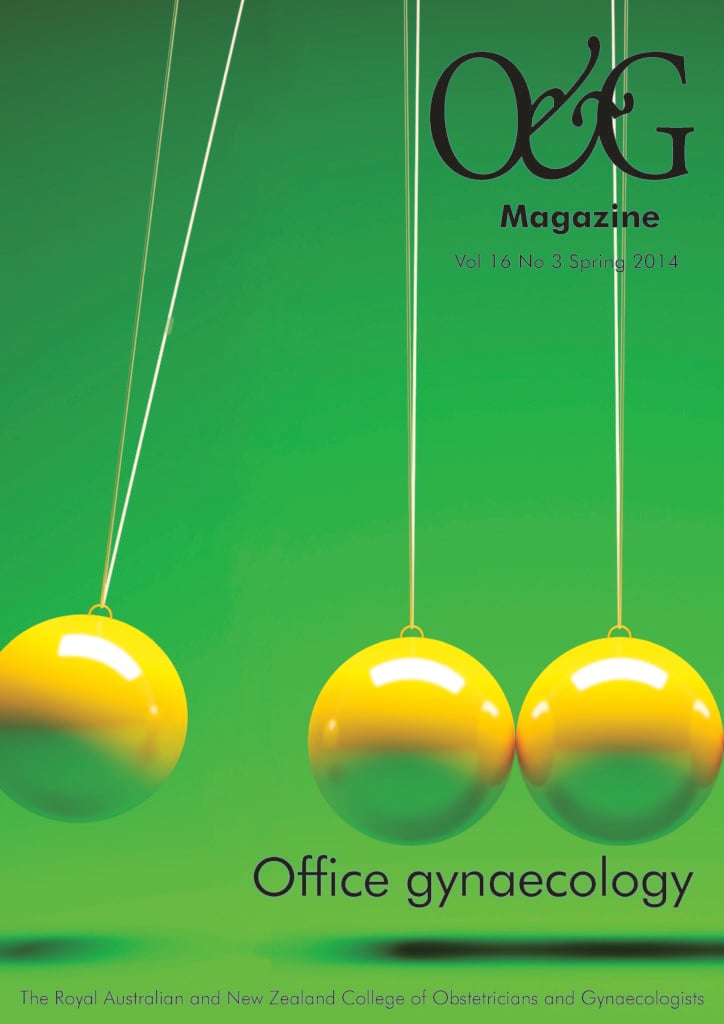As with any surgical procedure, office hysterscopy is easier when you have the right tools and a firm grasp of the techniques involved.
Hysteroscopy is a minimally invasive intervention that can be used to diagnose intrauterine and endocervical pathology. In addition to being used for diagnostic purposes, operative procedures such as tubal sterilisation, polypectomy and myomectomy, can easily be performed in a safe and efficacious manner.
A pioneer in the field of office hysteroscopy, Prof Bettocchi, in 2004 reported on 4863 operative hysteroscopic procedures where a vaginoscopic technique was used without analgesia or anaesthesia.1 As technology has further advanced and hysteroscopes have reduced in size, office procedures have become even more feasible. There have also been improvements in energy sources such as bipolar (as opposed to monopolar) that have decreased complications related to the operative distension media2, this has made operative hysteroscopy more acceptable. Furthermore, there are other equally compelling reasons for and advantages to performing office hysteroscopy. For example, it can be argued patients are more comfortable in an office setting. Moreover, by combining an immediate answer and treatment in a single visit, patient anxiety can be reduced. For the gynaecologist, there is satisfaction that the procedure is performed in an office, is cost effective and frees operating time for more complex procedures.
Hysteroscopes and sheaths
Most gynaecologists use rigid optical hysteroscopes, which offer wide-angle views of the uterine cavity and use fluid or gas as a distending media. The diameter of modern optical hysteroscopes that are used in office hysteroscopy is 2–2.9mm and these have different viewing angles; 30 degrees is most commonly used.
These optical diagnostic hysteroscopes are fitted with a sheath and have an outer diameter of between 2.5 and 5.5mm. Operative sheaths are also available with diameters of between 5.5 and 9.0mm (when using larger sizes a paracervical block or general anesthetic should be considered). These modern diagnostic and operative sheaths have isolated dual ports that provide continuous laminar flow of distending media, which improves operating vision.3
Operative instruments
Different instruments are available that were developed specifically for office hysteroscopic surgery. They tend to be semi-rigid, flexible and able to pass through a 3mm working channel. These include scissors, graspers and biopsy forceps. In addition, operating catheters can be passed through the hysteroscopic sheath as in Essure hysteroscopic sterilisation.3
Electrocautry and morcellation
Loop and needle electrodes, either monopolar or bipolar, can be used for office procedures. Loop devices are mainly used in resectoscopes. Modern loops are bipolar and so the distending media can be saline rather than glycine, although one problem with the use of bipolar is the generation of bubbles that can disturb operative vision.3
Tissue that is cut must be removed from the uterine cavity, which means taking the hysteroscope out after grasping the tissue. An advantage of this technique is that tissue is removed under direct vision, but the process can be long and arduous. One way around this to shorten operating time is to use morcellation. This has a short learning curve compared to standard cutting and retrieval of tissue. Different studies have been conducted; one such randomised controlled trial (RCT) compared conventional resectoscopy and morcellation among residents in training (Van Dongen et al). It found mean operating time for resectoscopy was 17.0 minutes (95 per cent CI 14.1 to 17.9 minutes) versus morcellation, which was 10.6 minutes (95 per cent CI 7.3 to 14.0 minutes). Furthermore, scores measuring the convenience of each technique on a visual analogue scale were in favour of morcellation. Examples of morcellation systems include Myosure from Hologic and Tuclear from Smith and Nephew.3
Office hysteroscopy procedure
The office procedure is similar to what we are all familiar with in the operating theatre, with passage of the hysteroscope through vagina and cervix to enable visualisation of the endometrial cavity. However, in reality there is more change to the office technique than just location. Primarily, the difference is that one has an awake and anxious patient and so the procedure must be completed in the shortest possible time with minimal discomfort. Therefore, one needs to reduce the learning curve associated with these procedures. I recommend starting this process of learning in the operating theatre with patients under general anaesthetic. The following points are important:
- Mastery of the 30-degree hysteroscope. One can then visualise the whole endometrial cavity with minimal movement just by moving the light lead. Furthermore, as anatomically the most sensitive part of the uterus is around the internal os and the isthmus, the use of angled hysteroscopy can avoid the fulcrum effect of the scope on that sensitive part of the uterus.
- Avoidance of cervical dilatation with dilators. The hysteroscope itself can be used to hydro-dilate the cervix. Once one is comfortable with the technique, the level of anaesthetic can be reduced to mimic office conditions and use instruments such those used in the office.
- Mastery of the vaginoscopic entry. At the beginning, one might need to use a speculum with or without a tenaculum, but with greater experience one could move towards vaginoscopy as it is the most comfortable technique to use in the office. Cooper et al compared direct vaginoscopy approach to the traditional approach of speculum/tenaculum. This study was a meta-analysis of six RCTs (n=1321) and used the patient’s experience as the primary measure. It found that the vaginoscopic approach was less painful than the traditional approach (standard mean difference -0.44, 95 per cent CI -0.65 to -0.22). There was no significant difference in the number of failed procedures between the two groups.4
Some pointers on the Bettochi vaginoscopic technique include:
- Enter into the vagina, aiming for deep in the posterior fornix.
- Initially place the hysteroscope light lead at 6 o’clock and try to localise the cervix.
- Once through the external os, follow the endocervical canal (seen as a ‘black hole’). At the internal os turn scope on its side by turning the light lead 90 degrees as this facilitates entry of scope into the uterine cavity.
Once one has confidence with the diagnostic part, then operative hysteroscopy should be the next step.
Preparation of the patient
Most women are anxious in lithotomy position and feel exposed. There should be protocols for dealing with this situation, as for any other intimate procedure. Firstly, patient educational materials should be provided. If the department policy is to see-and-treat, then patients should be given clear knowledge of this in advance with educational material so they can understand it. This facilitates the informed consent process.
The setting should be similar to current colposcopy clinics, with a lithotomy bed and change room within the procedure room. Gowns should be provided and there should be a nurse or a healthcare assistant present all the time to reassure patient and keep her calm. Everything should be set up prior to commencing the procedure so as to reduce operating time.
Pain management
- Verbal analgesia or no medication. Verbal reassurance is paramount and the nurse sitting with the patient should take that lead role. The communication loop between surgeon, nurse and patient should be always maintained.
- Oral analgesia. NSAIDs and paracetamol given one-to-two hours pre-procedure can be used. However, in a Cochrane review there was no evidence of a reduction in mean pain score.
- Paracervical block. This is the only pharmacologic intervention that revealed significant reduction in mean pain score within 30 minutes of the procedure.
- Intracervical local anaesthetic and lignocaine cream showed no evidence in reduction
Cervical preparation
A Cochrane review (not yet published) of 16 RCTs compared the use of misoprostol with placebo (control), progesterone (dinoprostone) and osmotic dilators. The findings were that the use of pre-procedure misoprostol was associated with greater ease of cervical dilatation when compared to no intervention. This was measured by the size of dilator that could pass the internal os without resistance (MD 0.60mm, 95 per cent CI 0.52 to 0.68), 11 studies, 753 participants, I2=99 per cent ). Fewer women in the misoprostol groups required cervical dilatation (OR 0.08; 95 per cent CI 0.04 to 0.15) and there were fewer abandonments of procedure (OR 0.10; 95 per cent CI 0.01 to 0.85), and fewer intraoperative complications (OR 0.27; 95 per cent CI 0.15 to 0.49. However, misoprostol was associated with significantly more side effects (OR 2.59; 95 per cent CI 1.15 to 5.79).
Compared to osmotic dilators (natural or synthetic), misoprostol was associated with reduced cervical width (MD -0.64; 95 per cent CI -0.98 to -0.30, three studies, 354 participants, I2=95 per cent) and increased number of women requiring cervical dilation (OR 5.96; 95 per cent CI 2.61 to 13.59).
Compared with dinoprostone, misoprostol was associated with a greater ease of cervical dilatation when measured by dilator size (MD 0.40mm; 95 per cent CI 0.21 to 0.59, one study, 310 participants), a decrease in the time to dilate the cervix (MD-4.60 seconds; 95 per cent CI -8.61 to -0.59, one study, 310 participants), fewer women requiring dilatation (OR 0.58; 95 per cent CI 0.34 to 0.98) and fewer intraoperative complications (OR 0.32; 95 per cent CI 0.12 to 0.83).
The conclusion was that misoprostol was superior to placebo or no treatment and progesterone, but inferior to osmotic dilators when used for cervical ripening prior to operative hysteroscopy. It was also associated with more side effects. Misoprostol was superior to prostaglandin.6
The conclusion was that misoprostol was superior to placebo or no treatment and progesterone, but inferior to osmotic dilators when used for cervical ripening prior to operative hysteroscopy. It was also associated with more side effects. Misoprostol was superior to prostaglandin.6
Antibiotics
Antibiotics are not recommended routinely. The exception is for women with cardiac disease, where surgical prophylaxis is indicated as per guidelines.
Office-based hysteroscopy is feasible with good evidence to support patient safety and satisfaction. Although technological improvements with small-diameter scopes make it more acceptable, skilled and motivated surgeons have also contributed in the advancement of this technique. Other advantages include reduction of multiple outpatient visits with a see-and-treat policy, avoiding use of general anaesthesia, cost-saving benefits and patient preference for the more familiar office environment.
References
- Bettocchi S, Ceci O, Nappi L et al. Operative hysteroscopy without anaesthesia: Analysis of 4863 cases performed with mechanical instruments. J Am Assoc Gynecol Laparoscopists 2004; 11:59-61.
- Martin Farrugia. Modern Operative hysteroscopy. 5th Edition. Litogratia Saba s.r.l. September 2012.
- Emanuel M. New Developments in hysteroscopy: Best practice and research. Clinical Obstetrics and Gynaecology. 2013; 27:421-429.
- Cooper NA, Smith P, Khan KS et al. Vaginoscopy approach to outpatient hysteroscopy: A systemic review of the effect on pain. BJOG. 2010; 117:532-539.
- Ahmed G, O’Flynn H, Attarbashi S et al. Pain relief for outpatient Hysteroscopy. Cochrane Database Syst. Review. 2010: 11.
- Personal communication from C Farquhar.





Leave a Reply